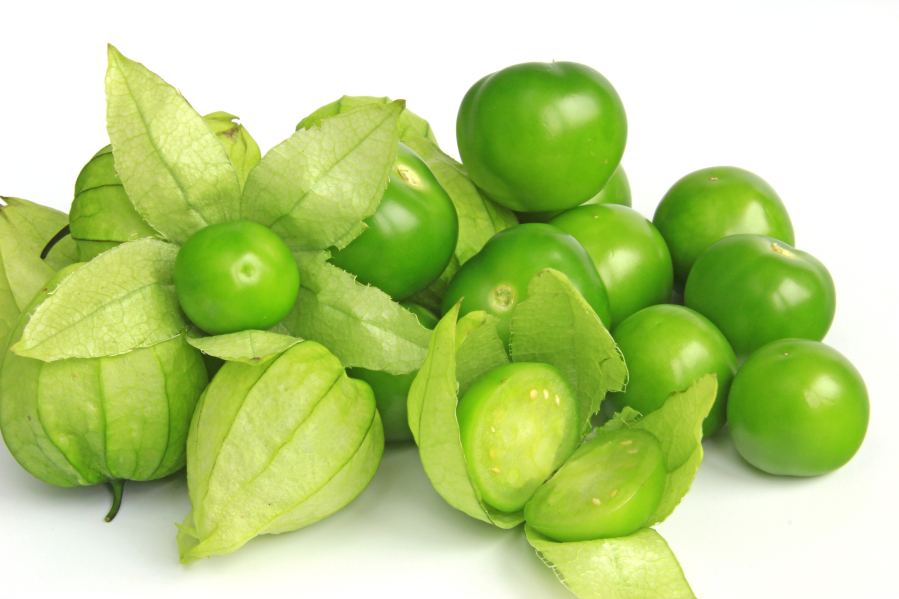Admit it, at one time or another you have found yourself looking for produce and paused on these round green things with paper skins on them. Don’t avoid them, but give them a try. So are they just green tomatoes? Actually, no they are not a tomato but the fruit of a different plant. Sometimes they are called Mexican green tomatoes or jamberries. Tomatillos are coated in a sticky residue and covered with a thin, papery husk on the outside. Why are they sticky? Turns out that this sticky substance is a natural deterrent against insects. Luckily for us the sticky film rinses off easily.
Tomatillos are most often used in salsas and sauces, although they can also be eaten raw. They do have a more acidic taste when eaten raw. Tomatillos can be found year-round as well as the local farmer’s markets.
When selecting tomatillos, the condition of the husk is a good indicator of its condition. If the husk is dry or shriveled then the fruit is probably not in good condition. Select tomatillos that have an intact, tight-fitting, light brown husk. If you peel back a small part of the husk, the fruit should be firm and free of blemishes.
Fresh tomatillos with the husk still intact may be stored in the refrigerator for up to two weeks. They are best stored in a paper bag. Tomatillos last a week longer in the refrigerator if the husks are removed and the fruit is placed in sealed plastic bags. Tomatillos can be frozen after removing the husks.
To use, first remove the husk and rinse gently under cold running water.
Below are four popular, simple methods to prepare tomatillos.
Raw or uncooked tomatillos are often in Mexican sauces. They add a fresh citrus-like flavor.
Blanching tomatillos before using them will mellow the flavor. Remove the husks and rinse before blanching for 5 minutes or until soft. Drain and crush or puree as directed in your recipe.
Fire roasting tomatillos will enrich sauces with a smoky flavor. Roast under the broiler, with a propane torch, or over an open flame such as a grill. Make sure the heat is quite hot before roasting. If the heat is not hot enough, the tomatillos will turn mushy before being charred.
Dry roasting will produce an earthy, nutty flavor. Place the tomatillos in a heavy fry pan (preferably a cast iron pan). Turn heat to low and roast for approximately 20 to 30 minutes, turning occasionally.
Tracey Benson is a Clark County WSU Extension Master Food Preserver. For additional recipes, food preservation and food safety information visit http://ext100.wsu.edu/clark/?p=1134. Have questions? Call MFP Helpline: 360-397-6060, ext. 5366, or join Facebook Discussion Group “WSU Home Food Preservers – Clark County.”
Tomatillo Green Salsa
Yield: 5 pint jars.
Recipe can be found in “So Easy to Preserve,” page 75.
CAUTION: Wear plastic or rubber gloves and do not touch your face while handling or cutting hot peppers. If you do not wear gloves, wash hands thoroughly with soap and water before touching your face or eyes.
5 cups chopped tomatillos
1½ cups seeded, chopped long green chiles
½ cup seeded, finely chopped jalapeño peppers
4 cups chopped onions
1 cup bottled lemon juice
6 cloves garlic, finely chopped
1 tablespoon ground cumin
3 tablespoons dried oregano leaves
1 tablespoon salt
1 teaspoon pepper
Hot pack: Remove the dry outer husks from the tomatillos; wash thoroughly. They do not need to be peeled or seeded. The jalapeno peppers do not need to be peeled. The skin of long green chiles may be tough. If you choose to peel chiles, read more about “Peppers” and peeling instructions in the introduction to “Canning Salsas.” Peel, wash and chop onions. Combine all ingredients in a large saucepan and stir frequently over high heat until mixture begins to boil, then reduce heat and simmer for 20 minutes, stirring occasionally. Fill hot salsa into hot jars, leaving ½ inch headspace. Remove air bubbles and adjust headspace if needed. Wipe rims of jars with a dampened clean paper towel. Adjust lids.
Process in a boiling water bath. Pints = 15 minutes



